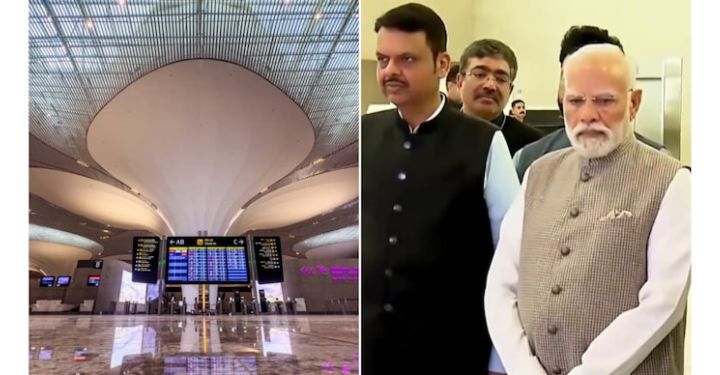Mumbai, India’s bustling financial capital, marked a historic milestone today with the inauguration of the first phase of the Navi Mumbai International Airport (NMIA) by Prime Minister Narendra Modi. Designed to relieve pressure on the overburdened Chhatrapati Shivaji Maharaj International Airport (CSMIA), this long-anticipated project signifies a massive leap forward for India’s aviation infrastructure and urban planning.
The NMIA, developed on 1,160 hectares, is one of the country’s most ambitious greenfield airport projects. Built with an estimated investment of ₹19,650 crore, the airport is expected to transform not only air travel in western India but also drive major socio-economic development in the surrounding regions.
A Symbol of Modern Infrastructure
Speaking at the inaugural event, Prime Minister Modi emphasized the airport’s role in accelerating India’s journey towards becoming a global economic powerhouse. “Navi Mumbai International Airport is not just an airport. It’s a gateway to the future, a symbol of how infrastructure must keep pace with ambition,” he said, addressing a large crowd of officials, dignitaries, and local stakeholders.
The newly completed Phase 1 includes a state-of-the-art passenger terminal, a 3,700-meter runway, and supporting infrastructure capable of handling 20 million passengers per annum (MPPA). Designed by the renowned Zaha Hadid Architects, the terminal architecture reflects Indian aesthetics — especially the lotus motif — combined with global functionality and sustainability standards.
Mumbai’s Dual-Airport Future Begins
CSMIA, currently India’s second busiest airport, has long operated beyond its optimal capacity. At peak hours, congestion has led to delays and operational inefficiencies. NMIA is now poised to share the load, positioning Mumbai among the world’s elite metropolitan regions to host two international airports.
In its final phase, NMIA aims to support 90 million passengers annually, making it one of the largest airports in the Asia-Pacific region. In the immediate future, operations will begin with domestic flights by December 2025, with international services rolling out in early 2026.
Seamless Multimodal Connectivity
What makes NMIA truly cutting-edge is its commitment to multimodal integration. The airport will be linked via:
- The Mumbai Trans Harbour Link (MTHL) — a 22-km sea bridge connecting Navi Mumbai to South Mumbai, expected to cut travel time drastically.
- National Highway 4B and Sion-Panvel Expressway, ensuring swift road connectivity from various city zones.
- Railway access through the nearby Targhar station, offering commuters a convenient option for reaching the terminal.
- Mumbai Metro Lines 8, 9, and 10, which are under development to create a seamless connection between the airport and key metro zones.
Additionally, NMIA will feature an Automated People Mover (APM) — a monorail-like system that will allow passengers to move between terminals and zones with ease.
Green and Smart: An Eco-Conscious Airport
In line with global sustainability trends, the airport integrates several green technologies:
- Rooftop solar panels capable of powering a significant share of airport operations.
- Rainwater harvesting systems and zero-discharge sewage design.
- Dedicated infrastructure to support Sustainable Aviation Fuel (SAF) storage and usage.
- Use of smart materials and energy-efficient lighting systems throughout the terminals.
These initiatives aim to make NMIA a carbon-neutral airport in its operational lifetime.
Economic Impact & Regional Transformation
The economic ripple effect of the airport is already being felt. NMIA is expected to:
- Create over 1 lakh direct and indirect jobs over the next five years.
- Boost real estate development in Panvel, Ulwe, and Taloja regions.
- Stimulate investment in logistics, hospitality, and warehousing along the airport corridor.
- Drive growth of tourism and international trade in Maharashtra.
With the airport’s development, Navi Mumbai’s long-standing dream of becoming a commercial powerhouse is becoming reality.
Challenges Ahead
Despite the optimism, NMIA faces critical implementation challenges in its next phases:
- Coordinating flight distribution between NMIA and CSMIA will require tight airspace management.
- Infrastructure like metro links and road overpasses are still under construction and must meet timelines to ensure seamless passenger movement.
- Environmental concerns, especially regarding mangrove protection and noise pollution, must continue to be addressed proactively.
- Airline partnerships and route allocations will need regulatory coordination, especially as international routes ramp up.
The Road Ahead
Civil Aviation Minister Jyotiraditya Scindia, who also attended the event, emphasized the transformative potential of NMIA. “This airport is the heart of India’s new aviation story. It’s not just about decongestion; it’s about reconnection, efficiency, and vision,” he remarked.
NMIA is being developed by Adani Airport Holdings Limited (AAHL) in partnership with CIDCO (City and Industrial Development Corporation of Maharashtra). AAHL, which also manages several other airports including Ahmedabad, Lucknow, and Jaipur, has said it aims to make NMIA one of the top 5 airports in Asia within a decade.
As the sun sets on the single-airport era of Mumbai, Navi Mumbai International Airport represents a new sunrise — one of possibilities, progress, and promise.

